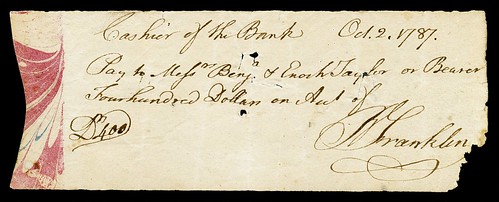
PREV ARTICLE
NEXT ARTICLE
FULL ISSUE
PREV FULL ISSUE
SECURITY MARBLING ON FINANCIAL INSTRUMENTSStudents of U.S. colonial currency will appreciate an article by Jake Benson in the latest volume of the American Journal of Numismatics. David Yoon also forwarded this excerpt from "Curious Colors of Currency: Security Marbling on Financial Instruments During the Long Eighteenth Century" in AJN 31. Thanks! -Editor 
National Numismatic Collection NNC 1979.1263.01594 The twenty-dollar bills authorized by the Continental Congress and dated May 10, 1775, feature a hand-marbled margin applied as a polychrome security device. The association of Benjamin Franklin with these notes has led scholars to attribute the concept of security marbling to his genius. This article shows that security marbling was first adopted by the Bank of England in 1695. It is further argued that both fractional reserve banking and the issuance of paper currency were intimately intertwined with the advent of paper marbling in England during the mid-seventeenth century. Evidence is presented to show that a Persian artist and émigré to India, Muhammad Tahir, was the true innovator behind the combed and chevron marbled patterns that were later applied to financial instruments. Introduction and Background
Significant evidence proves that the formative years of fractional reserve banking and issuance of paper currency were intimately intertwined with the advent of paper marbling in England. Together with new research on the origins and evolution of marbling in the Islamic world, and its subsequent spread to Europe, this essay provides an overview of security marbling throughout the "long eighteenth century" (ca. 1695–1815), until it was ultimately superseded by mechanized security printing. Wayne Homren, Editor The Numismatic Bibliomania Society is a non-profit organization promoting numismatic literature. See our web site at coinbooks.org. To submit items for publication in The E-Sylum, write to the Editor at this address: whomren@gmail.com To subscribe go to: https://my.binhost.com/lists/listinfo/esylum All Rights Reserved. NBS Home Page Contact the NBS webmaster 
|